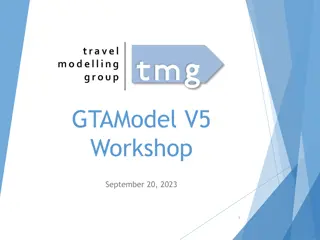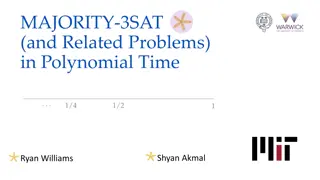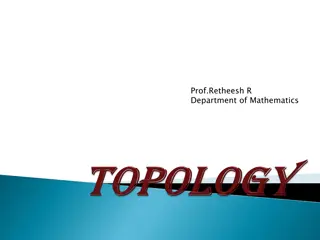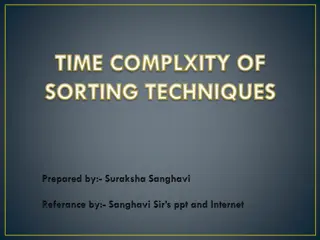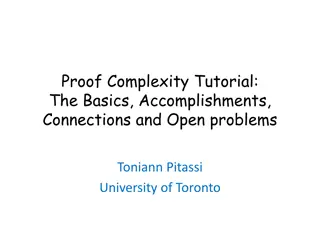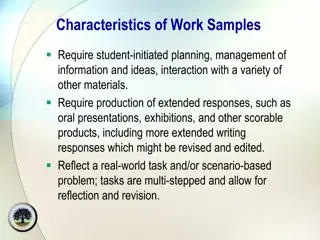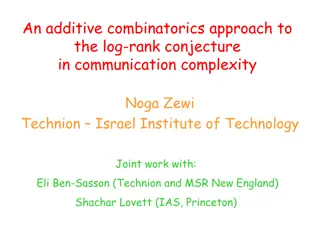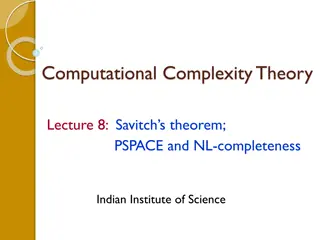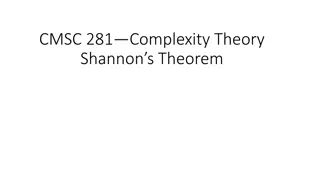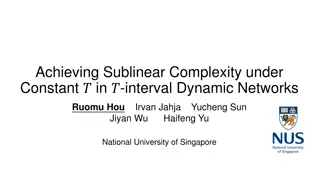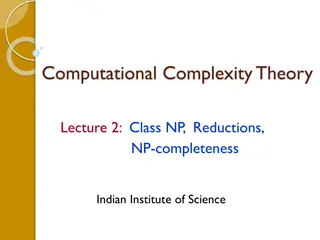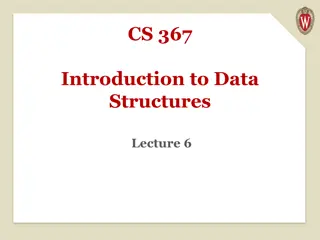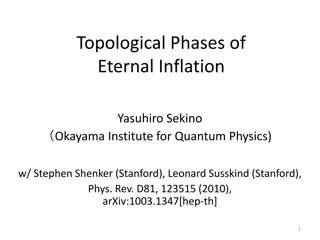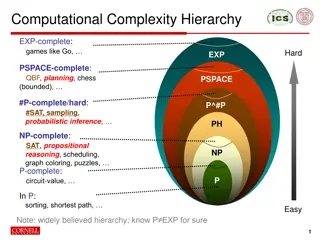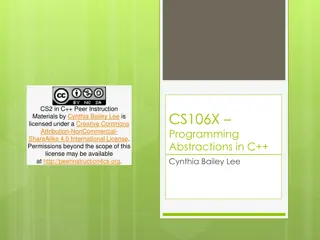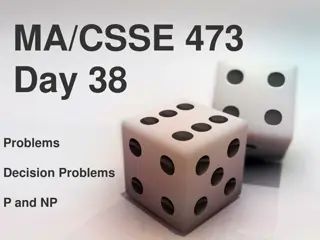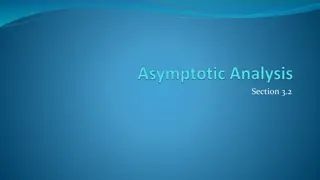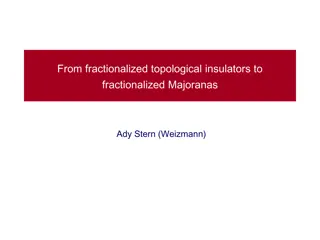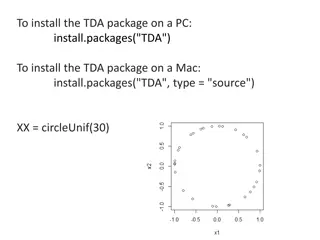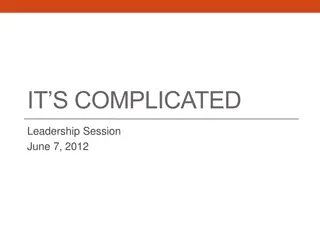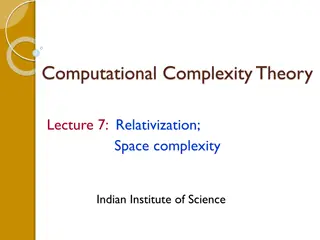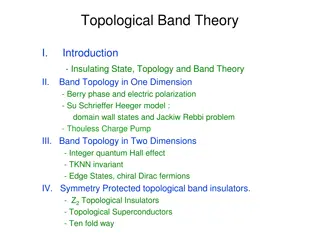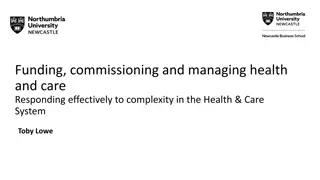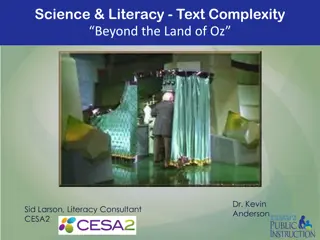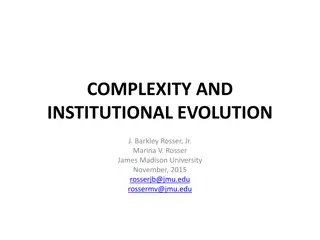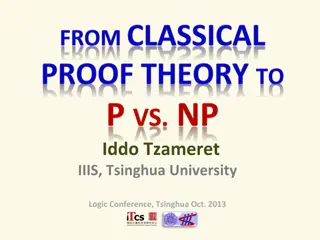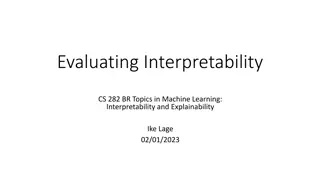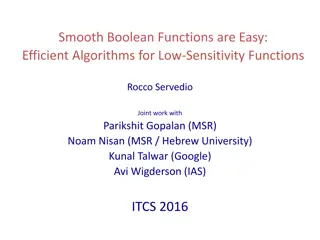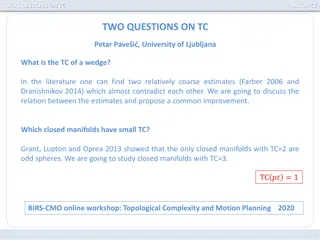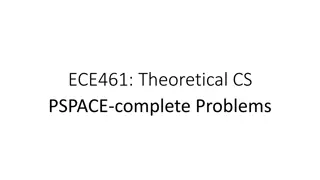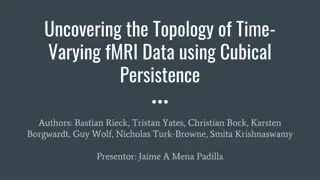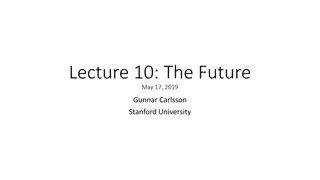Exploring Complexity and Complicatedness in Travel Demand Modeling Systems
Delve into the intricate world of travel demand modeling systems, where complexity arises from dynamic feedback, stochastic effects, uncertainty, and system structure. Discover the balance needed to minimize complicatedness while maximizing behavioral complexity in regional travel modeling. Uncover
0 views • 42 slides
Understanding Time Complexity in Algorithm Analysis
Explore the concept of time complexity in algorithm analysis, focusing on the efficiency of algorithms measured in terms of execution time and memory usage. Learn about different complexities such as constant time, linear, logarithmic, and exponential, as well as the importance of time complexity co
0 views • 73 slides
Understanding Complexity in Polynomial Time: MAJORITY-3SAT and Related Problems
Dive into the world of MAJORITY-3SAT and its related problems, exploring the complexity of CNF formulas and the satisfiability of assignments. Discover the intricacies of solving canonical NP-complete problems and the significance of variables in determining computational complexity.
3 views • 35 slides
Introduction to Topological Spaces and Examples
Topology is the study of surfaces derived from Greek words meaning surface and discourse. In mathematics, a topological space is a set with a family of subsets satisfying specific properties. Examples include the open ball, open set, indiscrete topology, discrete topology, co-finite topology, and co
0 views • 14 slides
Sorting Techniques: Complexity, Stability, and Cases
This content discusses various sorting techniques, their time complexity in worst, best, and average cases, stability, and types of sorts. It includes a comparison table listing algorithms such as Bubble Sort, Selection Sort, Insertion Sort, Quick Sort, and more, along with their respective complexi
0 views • 10 slides
Exploring Complexity in Computational Theory
Dive into a world of computational complexity and theory with a focus on topics such as NP, P, PH, PSPACE, NL, L, random vs. deterministic algorithms, and the interplay of time and space complexity. Discover insights on lower bounds, randomness, expanders, noise removal, and the intriguing question
0 views • 17 slides
Quantum Query Complexity Measures for Symmetric Functions
Explore the relationships between query complexity measures, including quantum query complexity, adversary bounds, and spectral sensitivity, in the context of symmetric functions. Analysis includes sensitivity graphs, the quantum query model, and approximate counting methods. Results cover spectral
0 views • 19 slides
Exploring Proof Complexity: The Basics, Achievements, and Challenges
Delve into the intricacies of proof complexity, covering propositional, algebraic, and semi-algebraic proof systems, lower bound methods, and algorithmic implications. Discover fundamental connections to complexity theory and open problems in the field.
0 views • 76 slides
Developing Effective Reading Work Samples
Creating reading work samples involves steps like identifying a topic, analyzing passages, drafting tasks, formatting, administering, scoring, and revising tasks. Considerations include text complexity, high student interest, and grade-level appropriateness. Text complexity is assessed quantitativel
0 views • 15 slides
Additive Combinatorics Approach to Log-Rank Conjecture in Communication Complexity
This research explores an additive combinatorics approach to the log-rank conjecture in communication complexity, addressing the maximum total bits sent on worst-case inputs and known bounds. It discusses the Polynomial Freiman-Ruzsa Conjecture and Approximate Duality, highlighting technical contrib
0 views • 9 slides
Overview of Computational Complexity Theory: Savitch's Theorem, PSPACE, and NL-Completeness
This lecture delves into Savitch's theorem, the complexity classes PSPACE and NL, and their completeness. It explores the relationship between time and space complexity, configuration graphs of Turing machines, and how non-deterministic space relates to deterministic time. The concept of configurati
0 views • 67 slides
Exploring Circuit Size Bounds in Complexity Theory
The article delves into Shannon's Theorem in Complexity Theory, discussing the upper bounds of circuit sizes for Boolean functions of n variables. It explores the 1-1 correspondence with 0-1 strings of length 2n and how Boolean functions can be expressed as CNF or DNF formulas. The computation of th
2 views • 19 slides
Achieving Sublinear Complexity in Dynamic Networks
This research explores achieving sublinear complexity under constant ? in dynamic networks with ?-interval updates. It covers aspects like network settings, communication models, fundamental problems considered, existing results, and challenges in reducing complexity. The focus is on count time comp
0 views • 14 slides
Enhancing Spectrum Efficiency with Low Complexity Erasure Codes in IEEE 802.11 Document
This document delves into the implementation of erasure codes for content channels in IEEE 802.11 systems. By utilizing erasure codes, spectrum efficiency can be boosted without significantly increasing the complexity of encoding and decoding processes. The discussion also covers the duplication of
0 views • 20 slides
Introduction to NP-Completeness and Complexity Theory
Explore the concepts of NP-completeness, reductions, and the complexity classes P and NP in computational complexity theory. Learn about decision problems, Boolean functions, languages, polynomial-time Turing machines, and examples of problems in class P. Understand how to deal with functional probl
0 views • 56 slides
Understanding Complexity in Data Structures
Introduction to logarithms, fractional exponents, and complexity analysis in algorithms. Exploring Big O notation to express algorithm complexity and examples demonstrating different time complexities. Learn about the importance of analyzing the efficiency of algorithms in data structures.
0 views • 79 slides
Understanding Topological Phases of Eternal Inflation in Metastable Vacuum Theory
Exploring the coupling of gravity in a theory with metastable vacuum through the lens of topological phases of eternal inflation. Investigating the behavior of false and true vacua, de Sitter space, and bubble nucleation, offering insights into string theory landscapes and observational implications
0 views • 26 slides
Topological Quintessence: Anomalous Cosmic Anisotropies and Dark Flow Directions
The consistency of Cold Dark Matter (CDM) with observational data has improved over the past decade, but tensions remain with various cosmic anomalies such as preferred anisotropy axes and dark flow directions. Topological Quintessence, a physical mechanism proposed by L. Perivolaropoulos and collab
0 views • 26 slides
Insights into Computational Complexity Hierarchy and SAT Algorithms
The computational complexity hierarchy explores classes of problems like EXP-complete, PSPACE-complete, and more. SAT algorithms, such as local search methods and survey propagation, offer new insights into practical complexity. Discover the interplay between tractable and intractable structures in
0 views • 12 slides
Understanding Complexity Theory in C++
Delve into the world of Complexity Theory with Cynthia Bailey Lee's peer instruction materials on P/NP definitions, decision vs. optimization problems, and the concept of O(2^n) time complexity. Explore the distinctions between problems in P and NP sets, grasp the implications of problem-solving spe
0 views • 27 slides
Understanding Decision Problems in Polynomial Time Complexity
Decision problems play a crucial role in computational complexity theory, especially in the context of P and NP classes. These problems involve questions with yes or no answers, where the input describes specific instances. By focusing on polynomial-time algorithms, we explore the distinction betwee
0 views • 32 slides
Understanding Big-Oh Notation in Time Complexity Analysis
Big-Oh notation in algorithm analysis signifies how the runtime of an algorithm grows in relation to the input size. It abstractly characterizes the worst-case time complexity, disregarding constants and lower-order terms. The concept of Big-Oh, along with Big-Omega and Big-Theta, helps in comparing
0 views • 18 slides
Exploring Fractionalized Topological Insulators and Majoranas
This discussion delves into the transition from fractionalized topological insulators to fractionalized Majorana modes, highlighting key concepts in topological phases of matter, quantum Hall effects, and interactions in fractional quantum Hall effects. Emphasis is placed on 3D topological insulator
0 views • 23 slides
Understanding Topological Data Analysis (TDA) with Persistence Diagrams
Dive into the world of Topological Data Analysis (TDA) by learning how to install the TDA package on different operating systems and interpreting the plots of data points, barcodes, and persistence diagrams. Explore the visualization of cycles in different dimensions and understand the concepts of H
0 views • 17 slides
Text Complexity and Reading Strategies in Education Sessions - June 7, 2012
Explore the engagement with text complexity and effective reading strategies in an educational workshop conducted on June 7, 2012. Delve into discussions on understanding text complexity levels, using margin notes and graphic organizers, and sharing key takeaways. Reflect on the challenges U.S. stud
0 views • 10 slides
Oracle Turing Machines in Computational Complexity Theory
The lecture delves into the concept of Oracle Turing Machines and their role in proving computational complexity results, such as the limitations of diagonalization in demonstrating P vs. NP. Oracle Turing Machines are defined as Turing Machines with access to a special query tape and states for ora
0 views • 59 slides
Exploring Topological Band Theory and Quantum Phases in Electronic Matter
Delve into the fascinating realm of topological band theory, examining the insulating state, band topology in different dimensions, symmetry-protected topological band insulators, and the interplay between symmetry and topology. Uncover the principles underlying matter symmetry, quantum phases, and
0 views • 29 slides
Managing Complexity in Health & Care Systems
Addressing the challenges of complexity in health and care systems, this content delves into embracing complexity, working in complex environments, and understanding the emergent nature of complex systems. It highlights the importance of being human, continuous learning, and nurturing healthy system
0 views • 28 slides
Understanding Text Complexity in Science and Literacy Education
Exploring the concept of text complexity beyond the familiar realm of Oz, this presentation delves into quantitative and qualitative measures, reader and task considerations, and steps to assess text complexity. Various resources and examples are provided to help educators gauge and improve the comp
0 views • 43 slides
Holographic Complexity in Hybrid De Sitter Spacetime
The research delves into holographic complexity in a hybrid de Sitter spacetime, exploring the AdS/CFT correspondence, quantum information in the bulk, and computational complexity. It also examines the volume of the ERB, evolution of complexity in CFT, and probes cosmological horizons using hologra
0 views • 12 slides
Complexity and Institutional Evolution in Economics
This paper explores the relevance of complexity theory in studying economic institutional evolution, focusing on the concepts of cumulative causation, increasing returns, and hierarchical emergence. It discusses the dynamic and computational complexity theories, highlighting the role of systems foll
0 views • 24 slides
Understanding Bounded Arithmetic and Definable Functions in Complexity Theory
Bounded arithmetic, as explored in complexity theory, focuses on theories like PA but with restrictions on formulas. The comprehension axiom determines sets that can exist, and TC is a first-order arithmetic theory defining functions within a specific complexity class. The witnessing theorem in TC e
0 views • 16 slides
Evaluating Interpretability in Machine Learning: Understanding Human-Simulatability Complexity
The paper discusses evaluating interpretability in Machine Learning by examining human-simulatability complexity and the relationship between decision set complexity and interpretability. It explores different factors affecting interpretability through user studies and highlights the significance of
0 views • 41 slides
Understanding Topological Sorting in Spark GraphX
Explore the essential concepts of Topological Sorting in Spark GraphX, including necessary background knowledge, stand-alone versus distributed implementations, and practical examples. Delve into Spark GraphX's capabilities, such as RDD manipulation, high-level tools, and graph parallel computation.
0 views • 56 slides
Understanding Complexity Measures of Boolean Functions
This work delves into the intricate world of complexity measures for Boolean functions, exploring concepts such as certificate complexity, decision tree depth, sensitivity, block sensitivity, PRAM complexity, and more. It sheds light on the relationships among different complexity measures and provi
0 views • 36 slides
Interactive Proofs in Complexity Theory
Delve into the realm of interactive proofs in complexity theory, exploring concepts such as completeness, soundness, and efficiency. Discover how interactive proof systems can be utilized in scenarios like graph isomorphism and their implications on the complexity classes NP and coNP. Uncover the in
0 views • 40 slides
Understanding Topological Complexity Estimations and Regularity of Spaces
Discussion on the varying estimates of topological complexity for wedges, closed manifolds, and other spaces, along with the analysis of TC-regularity. This includes contrasting estimates, proofs, and examples of TC regularity in different spaces like spheres and Lie groups.
0 views • 11 slides
Understanding PSPACE-Complete Problems in Complexity Theory
This content delves into complexity theory, exploring PSPACE-complete problems and their relevance within the realm of theoretical computer science. It covers concepts such as time complexity classes, P vs. NP dilemma, NP-complete languages, space complexity, PSPACE vs. NPSPACE, and PSPACE completen
1 views • 19 slides
Uncovering the Topology of Time-Varying fMRI Data using Cubical Persistence
Authors present a novel framework to transform time-varying fMRI data into topological representations, utilizing cubical persistence to analyze brain state trajectories and cluster participants based on topological features in blood flow in the brain, providing insights into cognitive processes. fM
0 views • 11 slides
Advanced Topics in Topological Data Analysis: Research Highlights
Explore cutting-edge research in Topological Data Analysis (TDA) through topics such as Mapper Stability Measures, Deep Learning advancements, Vectorization techniques, Generalized Persistence modeling, Stochastic Aspects analysis, Formal Properties of Persistence, and Complement Problems in TDA app
0 views • 8 slides
